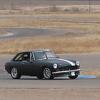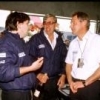Nigel mentioned that Kevlar replaced fiberglass in the M23 model's later years, and Rob mentioned calling on the McLaren works back when he worked for Specialised Mouldings... I'm curious to probe the connection a little deeper. To what extent was Specialized involved in McLaren's use of Kevlar? Was Specialized also involved in McLaren's innovative use of sandwich construction on the M23?
Speciali
Sed Mouldings was split into three main sections, the pattern shop where all the new prototype work was created, and where things could be quite secretive, the mould area where most of the cleverer stuff including any work for F1 customers would have been done, and the production shop which did all the run of the mill output. I spent most of my time in the first of these, and didn't have much to do with the moulding side, though it wasn't a large company, and we all knew about most of what went on, the first two departments worked together quite closely. Kevlar was just becoming economic towards the end of my time there, and I'd guess that its use had been suggested to McLaren by SM as a worthwhile though expensive improvement on what they'd used before. McLaren always wanted the best, and weren't as cost-conscious (or tight fisted) as most other customers, if something could be improved, they'd usually go for it, whatever the expense, though they were anything but profligate. Used properly Kevlar should result in stronger mouldings with a useful weight saving over what I suppose we have to refer to as 'traditional' or 'conventional' fibreglass, but it's awful stuff to work with, or at least it was back then. I suspect that at least initially, SM would have used it as a straight substitute for glass materials using the same polyester resins, though you'd achieve far better results using epoxy resin, which is how it's almost always used today. Apart from being more expensive and needing specially trained operators, the use of epoxy demands proper curing ovens, which SM probably acquired eventually, but hadn't even been considered during my time there, which included most of the M23 period. On the sandwich construction question, as far as I know this was all done using injected two component polyurethane foam. This would have been carried out by McLaren at their factory, and although they may have asked SM for advice on its use, I doubt if there would have been any other involvement between the two companies. Our most frequent contact was with Nigel's dad Don Beresford, and since he'd have seen to carrying out the sandwich sidepod construction of the M23 monocoques, I'm sure that there would have been friendly discussions, though probably nothing more than that. McLaren's place in David Road was always 'eat off the floor clean' each time I was there, so I'm not sure if any messing about with unpleasant materials like this would have been done in any of the usual assembly areas, probably Nigel can tell us more.
Edited by kayemod, 07 January 2012 - 15:36.



























